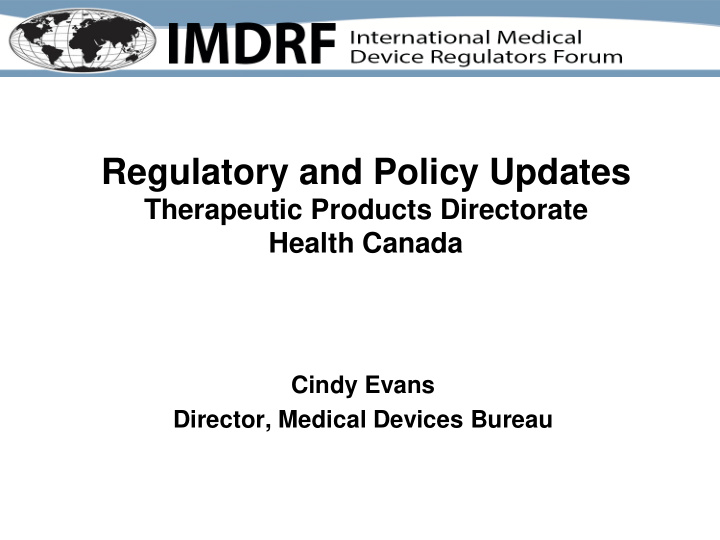



Regulatory and Policy Updates Therapeutic Products Directorate Health Canada Cindy Evans Director, Medical Devices Bureau
Non-Corrective (NC) Contact Lenses • Bill C-313, An Act to Amend the Food and Drugs Act (non-corrective contact lenses) will deem NC contact lenses as devices under the Food and Drugs Act – Bill C-313 received Royal Assent on December 14, 2012. • To operationalize these changes, amendments to the Medical Devices Regulations (MDR) are required. 2
NC Contact Lenses (2) • Existing rules in the MDR would classify NC contact lenses as Class II medical devices. • Health Canada will seek amendments to the MDR to: – ensure that NC contact lenses will be licensed prior to their sale; and – address the fact that where NC contact lenses have no therapeutic effect, requirements for effectiveness data are not applied. 3
NC Contact Lenses (3) • Amendments to the Food and Drugs Act and the Medical Devices Regulations would come into force at the same time. • Until then, non-corrective contact lenses would continue to be subject to the Canada Consumer Product Safety Act and not require a licence from Health Canada prior to being imported into or sold in Canada. 4
Class II Medical Device Labelling • Health Canada is considering a proposal to require that Class II medical device labels are included as part of a Class II medical device licence application. – Currently, Class II medical device manufacturers include an attestation that the medical device label is compliant with the labelling requirements in the Medical Devices Regulations. 5
Investigational Testing • In November 2013, the Medical Devices Bureau updated acceptance letters for investigational testing applications (ITAs) to encourage voluntary registration of medical device clinical investigations. 6
Investigational Testing (2) • A notice to industry also informed stakeholders that TPD will share, upon request, key information* about ITAs which were granted approval after the effective date. • Examples*: protocol title; device name; medical condition; study population; authorization date; end date of the study; and name of manufacturer/importer. 7
Investigational Testing (3) • For information about a particular clinical investigation, such as patient enrolment criteria, potential investigational testing sites, and status of the investigation, enquirers are directed to the device manufacturer/importer and treating physician. 8
Bill C-17 On December 6, 2013 the Government of Canada introduced Bill C-17: Protecting Canadians from Unsafe Drugs Act (Vanessa’s Law) New legislation to update the laws that apply to drugs and medical devices to increase patient safety in key areas of concern and is currently being review in parliament. 9
Protecting Canadians from Unsafe Drugs Act (Vanessa's Law) (Bill C-17) Proposed changes to the definition of “device” in the Food and Drugs Act : – narrowed scope for physical description of a device (what it is) and inclusion of mode of action (how it works) – less prescriptive distinction between “drug” and “device” to better address drug/device combination products – in-vitro reagents are explicitly included in definition 10
Protecting Canadians from Unsafe Drugs Act (Vanessa's Law) (Bill C-17) The proposed amendments to the Food and Drugs Act include: 1.Power to compel information, tests/studies and reassessments 2.Power to compel a label change 3.Power to recall unsafe therapeutic products 4.Tougher measures for those that do not comply 5.Ability to incorporate by reference 11 6.Mandatory reporting by healthcare institutions
Recommend
More recommend